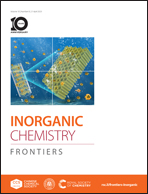Site preference and defect engineering of a highly efficient blue-emitting phosphor Sr2SiO4:Ce3+/K+ toward thermally enhanced luminescence†
Abstract
The blue-emitting phosphor is one of the trichromatic phosphors essential for the development of near-ultraviolet (nUV) pumped phosphor-converted white light-emitting diodes (pc-WLEDs). Efficiency and thermal stability are two critical factors for the potential application of phosphors in solid-state lighting. In this work, we report a highly efficient blue-emitting phosphor, α-Sr2SiO4:0.02Ce3+/0.02K+ (emission peak at 425 nm) with superior thermally enhanced photoluminescence properties. The Rietveld refinement results suggest that Ce3+ preferentially occupies the nine-fold coordinated Sr2 site only whereas K+ occupies both Sr1 and Sr2 sites in the host structure. Its emission intensity gradually increases with increasing temperature and retains 120% of its room-temperature peak intensity at 250 °C. Besides, its luminescence spectral peak does not shift at elevated temperatures. Under nUV irradiation, the phosphor is highly luminous with an excellent internal quantum efficiency (IQE) of 91.7%. The abnormal thermal quenching phenomenon can be ascribed to the defect energy levels introduced by defect engineering using an aliovalent doping strategy of Ce3+ and K+ in the α-Sr2SiO4 host structure. The as-fabricated WLED prototypes demonstrated the great potential of the highly efficient blue-emitting phosphor with superior thermal stability for solid-state lighting applications.



 Please wait while we load your content...
Please wait while we load your content...